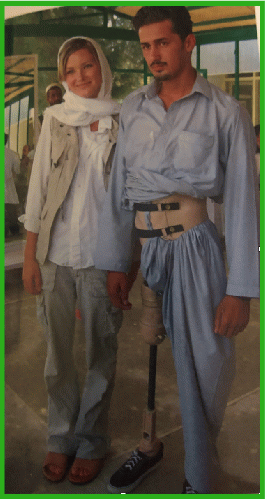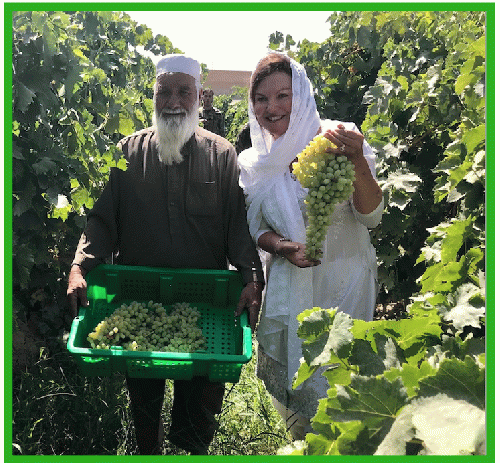
Heidi's daughter, Kyleigh, with Afghani mine survivor, Fawad Afa, August 2005
(Image by courtesy of Heidi Kuhn) Details DMCA
HK: Removing landmines is half the problem. Planting completes the value chain that has been broken due to war. Landmines hold the land hostage long after the guns of war have silenced.
Once safely removed, the farmers must be taught modern farming techniques which were once passed on from generation to generation. This linkage is often broken, as men took to the frontline of battle, leading with the sword not the shovel. Lives were lost, and widows allowed the grapevines to grow on dirt mounds with bruised fruits. The children did not learn the trade of their fathers as they had been killed in battles on their once rich farmland, and the agricultural knowledge of farmers also became a casualty to war.
In 2002, shortly after the 9/11 attacks, we focused our MINES TO VINES program in Afghanistan--the most heavily mined country in the world. Afghanistan is a country 80% dependent upon agriculture, yet landmines prevent farmers from yielding a harvest of hope. There are 66 varieties of grapes, and the popular Thompson Seedless Grape packed in our children's lunch boxes in the United States had its origin in this region. With due respect to the Muslim faith, we never ferment the grapes--only raisins and fresh fruit. As we peered over the vast horizon of the Shomali Plains north of Kabul, it seemed like such a paradox to have landmines in a country which was once dubbed 'The Garden of Central Asia.'
In 2014, Afghan agricultural exports averaged $250 million. Roots of Peace CHAMP program (Commercial Horticulture Agricultural Marketing Program) funded by USAID increased agricultural exports to over $1.4 billion by the end of 2019. The vision of turning MINES TO VINES has greatly impacted the GDP of the nation, according to President Ashraf Ghani.
Roots of Peace has pioneered the economics of peace on former war-torn lands...

Afghani farmer cultivates grapes in vineyard sponsored by Diane Disney Miller. Old minefields are now thriving vineyards.
(Image by courtesy of Heidi Kuhn) Details DMCA
JB: Let's not jump over this part too quickly. How did you build trust with the community? How did you help them see the value of new methods when tradition is so strong and change so hard? I imagine that it didn't always go smoothly. Can you give an example?
HK: The first time we visited Afghanistan in 2003, we learned an important American lesson--listen to the locals and do not assume that your cultural values are a solution to the problem! The Afghans were not trusting of Americans entering their country offering to improve their livelihoods following the recent bombings. Trust needed to be earned.
It took a great deal of time to convince the local elders to provide a demonstration plot to improve yields, as there was much distrust among the community. Finally, we found a respected elder who was open to our new ideas! Together, we found a small demonstration plot located near Shakudara (Sugar Mountain) nestled between the Hindu Kush mountains.
We entered his vineyard and immediately began to prune the vine to double the yield.
Farmers were aghast! Here were Americans with pruning hooks, cutting the rootstock down to the bare bone! Certainly, they must be terrorists! Again, we told them to trust us.
We introduced the wooden trellis posts, and told them we would return the next year.
When we arrived in the Spring, 2004, we were shocked to see that the Afghan community had cut down all the wooden trellis posts which we had carefully cemented into the ground.
Asking them why they would not listen to our improved modern agricultural techniques, they looked us in the eye and said, "Respectfully, this was the coldest winter on record. We needed the wood to burn fires to keep our families warm and cook meals over the stove."
Suddenly, we realized that we imposed our Western ideas on a culture focused on survival.
(Note: You can view every article as one long page if you sign up as an Advocate Member, or higher).





